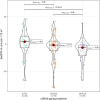Urinary Dickkopf-3 as a Potential Marker for Estimated Glomerular Filtration Rate Decline in Patients With Heart Failure
- PMID: 39604022
- PMCID: PMC11681579
- DOI: 10.1161/JAHA.124.036637
Urinary Dickkopf-3 as a Potential Marker for Estimated Glomerular Filtration Rate Decline in Patients With Heart Failure
Abstract
Background: Patients with chronic heart failure (HF) show an increased risk for the occurrence of chronic kidney disease and cardiorenal syndrome. Urinary Dickkopf-3 (uDKK3), a stress-induced, tubular profibrotic glycoprotein, may be elevated in HF as early as in New York Heart Association class I HF and may indicate subsequent decline in estimated glomerular filtration rate (eGFR).
Methods and results: uDKK3 levels in patients with HF and controls were measured by enzyme-linked immunosorbent assay. eGFR was determined up to 5 years in HF. Change in eGFR was assessed with respect to baseline uDKK3 using (mixed-effect) linear and logistic regression models. A total of 488 patients with chronic HF and 45 control patients were included. Patients with HF showed higher median uDKK3 levels than controls (259.6 pg/mg creatinine [interquartile range (IQR), 119.2-509.4 pg/mg creatinine] versus 107.5 pg/mg creatinine [IQR, 60.5-181.2 pg/mg creatinine], P<0.001). Regression models demonstrated a significant association between log uDKK3 and the decline in eGFR during a median of 13 months (IQR, 12-59 months) (estimated higher eGFR loss, 0.8039 mL/min per 1.73 m2/year [95% CI, 0.002-1.606 mL/min per 1.73 m2/year], P=0.049; odds ratio, 1.345 [95% CI, 1.049-1.741], P=0.021). uDKK3 levels ≥354 pg/mg creatinine were associated with a significantly higher risk for eGFR decline at 1-year follow-up (estimated higher eGFR loss, 4.538 mL/min per 1.73 m2 [95% CI, 1.482-9.593 mL/min per 1.73 m2]), P=0.004). Even patients with HF without chronic kidney disease (n=334) had higher uDKK3 levels compared with controls (233.4 [IQR, 109.0-436.9 pg/mg creatinine] versus 107.5 [IQR, 60.5-181.2 pg/mg creatinine], P<0.001).
Conclusions: The present findings indicate that uDKK3 is a promising prognostic biomarker for subsequent eGFR decline in patients with HF, irrespective of the presence of chronic kidney disease and even in the early stages of HF. This potential allows for early intervention to mitigate the deterioration of kidney function. Further investigation is warranted to validate its clinical utility.
Keywords: Dickkopf‐3; cardiorenal syndrome; estimated glomerular filtration rate; heart failure.
Conflict of interest statement
None.
Figures





References
-
- Heerspink HJL, Perco P, Mulder S, Leierer J, Hansen MK, Heinzel A, Mayer G. Canagliflozin reduces inflammation and fibrosis biomarkers: a potential mechanism of action for beneficial effects of sglt2 inhibitors in diabetic kidney disease. Diabetologia. 2019;62:1154–1166. doi: 10.1007/s00125-019-4859-4 - DOI - PMC - PubMed
MeSH terms
Substances
LinkOut - more resources
Full Text Sources
Medical
Research Materials
Miscellaneous

